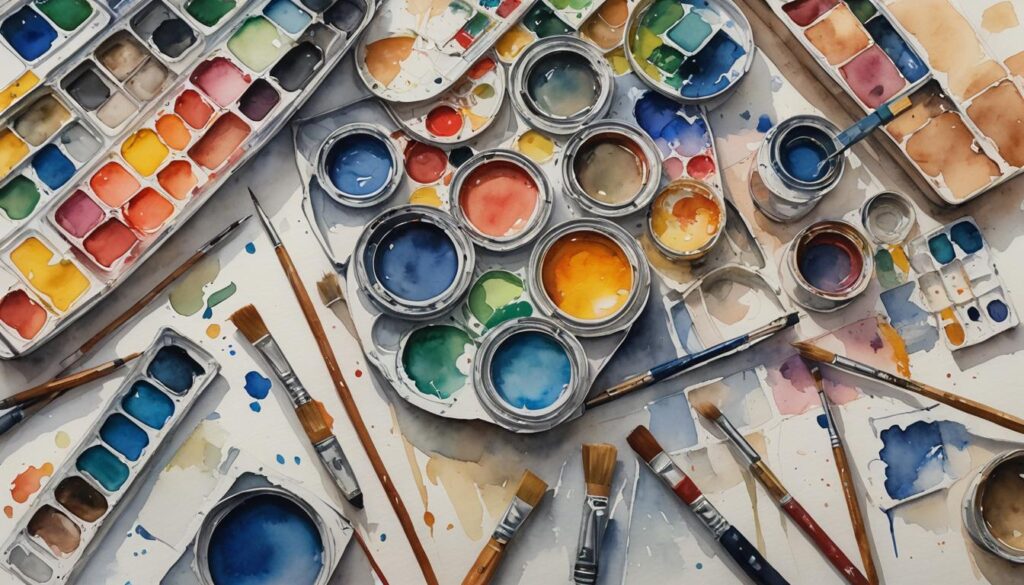Starting your acrylic painting journey doesn’t require expensive art supplies or years of training. With the right acrylic painting tools, you can create stunning artwork from day one. This comprehensive guide covers everything you need to know about selecting, using, and maintaining your acrylic painting equipment.
Key Points Summary
• Synthetic brushes are essential – natural bristles deteriorate quickly with acrylic paint
• Stay-wet palettes extend working time – keeping paint workable for hours instead of minutes
• Complete starter kit costs under $100 – quality basics are more important than expensive gear
• Proper brush care doubles lifespan – two-jar cleaning system and upright storage
• Palette knives create texture and mix colors – plastic versions work as well as metal for beginners
• Canvas panels beat stretched canvas for practice – more affordable and won’t warp
• Mediums expand creative possibilities – retarder for blending, gloss for glazing effects
• Workspace organization improves results – good lighting and tool accessibility matter
Essential Acrylic Painting Tools: Your Complete Starter Kit
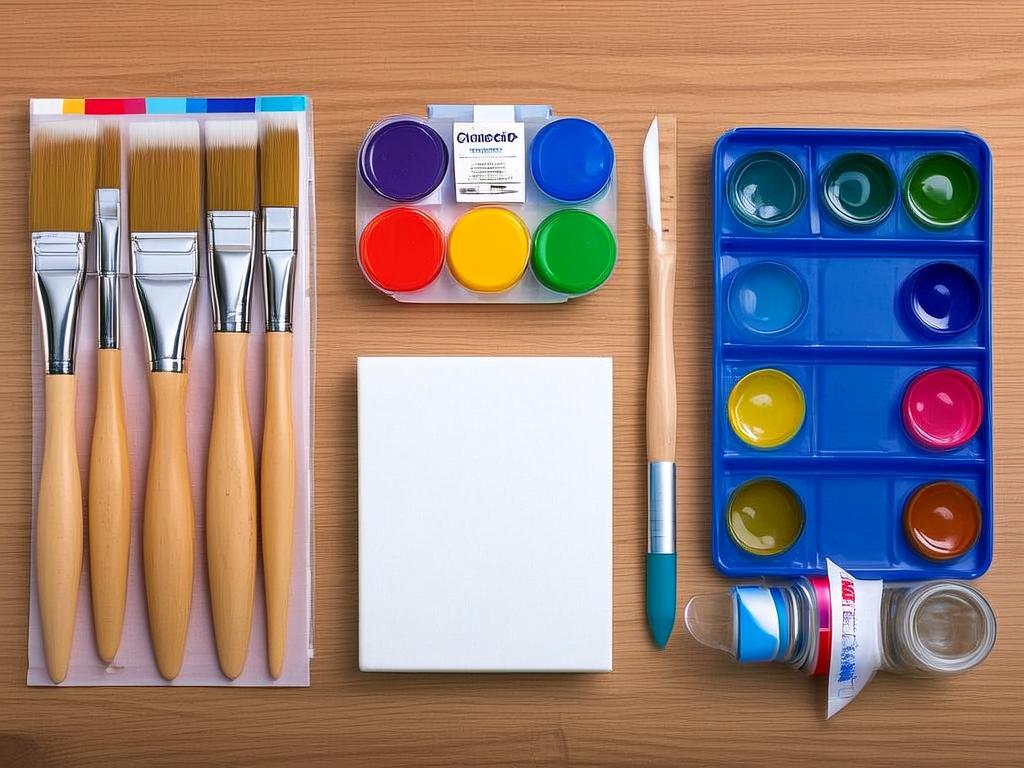
| Tool Category | Essential Items | Why You Need Them | Budget Range |
|---|---|---|---|
| Brushes | Synthetic flats, rounds, filberts | Natural bristles deteriorate with acrylics | $12-25 |
| Palette System | Stay-wet palette or disposable sheets | Prevents paint from drying too quickly | $15-30 |
| Mixing Tools | Palette knife (plastic or metal) | Essential for color mixing and texture | $8-20 |
| Painting Surfaces | Canvas panels, stretched canvas, paper | Foundation for your artwork | $10-40 |
| Water Station | Two jars plus spray bottle | Critical for brush care and paint consistency | $5-15 |
| Mediums | Retarder, gloss medium, flow aid | Extends working time and effects | $8-25 each |
| Protection | Varnish or protective finish | Preserves completed artwork | $12-30 |

Choosing the Right Brushes for Acrylic Painting
Synthetic brushes are non-negotiable for acrylic painting. Unlike watercolors, acrylics contain polymer binders that can destroy natural hair brushes. Quality synthetic brushes maintain their shape, resist paint buildup, and last significantly longer. Whether you’re following our complete guide to acrylic painting for beginners or advancing your skills, the right brushes make all the difference.
Essential Brush Shapes

Flat Brushes excel at covering large areas, creating sharp edges, and applying washes. They’re perfect for skies, backgrounds, and architectural elements.
Round Brushes offer versatility for detail work, line painting, and controlled washes. They’re essential for portraits, fine details, and organic shapes.
Filbert Brushes combine the benefits of flats and rounds, creating soft edges and natural-looking brush strokes. They’re ideal for blending and creating organic textures.
Brush Care Essentials
Proper brush maintenance dramatically extends their lifespan. Use a two-jar system: one for initial cleaning and another for final rinses. Always reshape brush tips while damp and store brushes upright or flat—never tip-down in water.
Palette Systems: Keeping Your Paint Workable
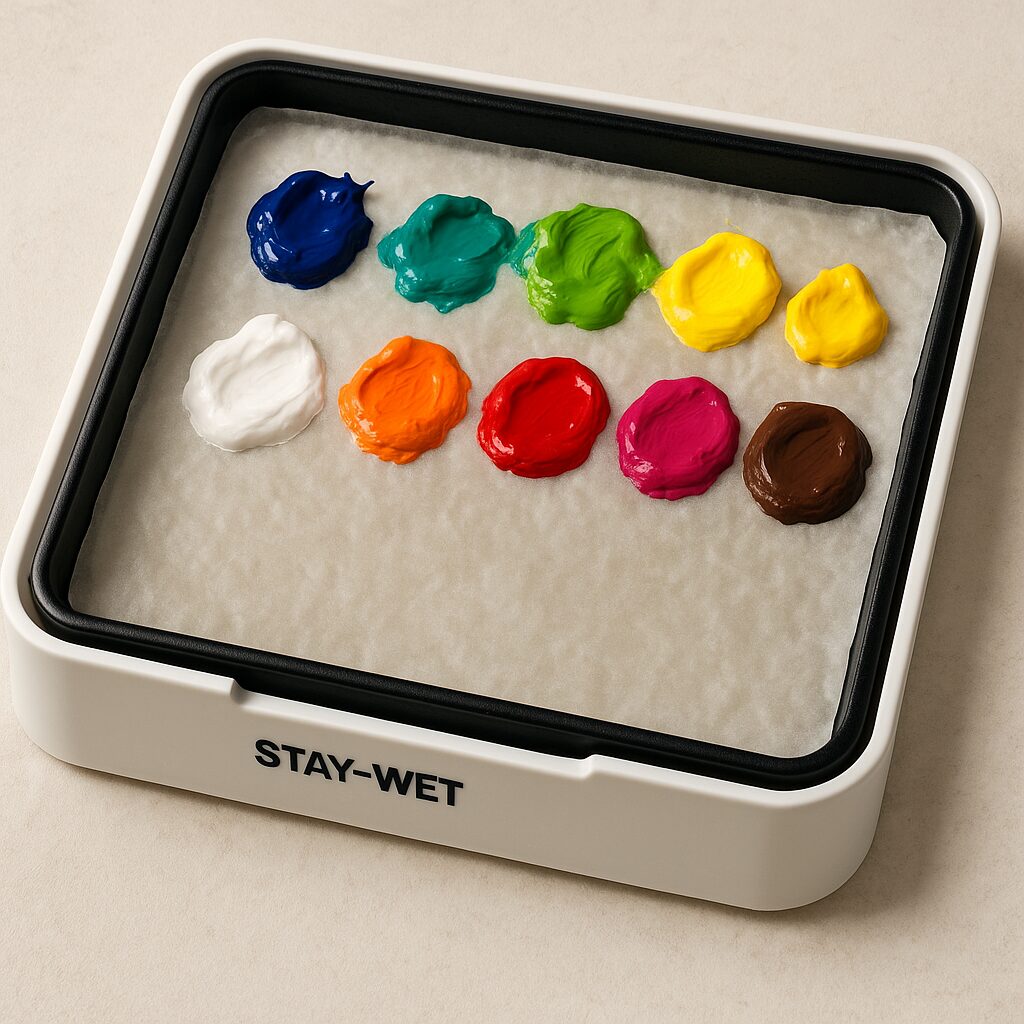
Stay-wet palettes revolutionize acrylic painting by maintaining paint workability for hours or even days. These systems use a damp sponge beneath parchment paper to create a humid environment that prevents paint from drying.
DIY Stay-Wet Palette
Create your own with a plastic container, wet paper towels, and parchment paper. This budget-friendly option works just as well as commercial versions.
Surface Selection: Canvas, Paper, and Boards
Canvas panels offer affordability and stability, making them perfect for practice and studies. They don’t warp like stretched canvas and provide excellent tooth for paint adhesion.
Stretched canvas provides the traditional painting experience and is ideal for finished pieces intended for display or sale.
Acrylic paper offers a sketchbook-friendly option for studies and experimentation. Look for paper specifically designed for acrylics with adequate weight and texture.
Mediums: Enhancing Your Acrylic Paint
Retarder medium slows drying time, allowing for smoother blending and wet-into-wet techniques. This is crucial for realistic painting styles requiring seamless transitions.
Gloss medium increases transparency and creates glossy finishes. It’s excellent for glazing techniques and enhancing color vibrancy.
Flow aid improves paint flow and reduces brush marks, creating smoother applications especially useful for large areas. Understanding color theory for acrylic painters becomes easier when your mediums help colors blend seamlessly.
Color Mixing and Palette Knives
Palette knives serve dual purposes: mixing colors and creating textural effects. Plastic knives resist corrosion and are safer for beginners, while metal knives offer superior flexibility and precision.
Texture Techniques with Palette Knives
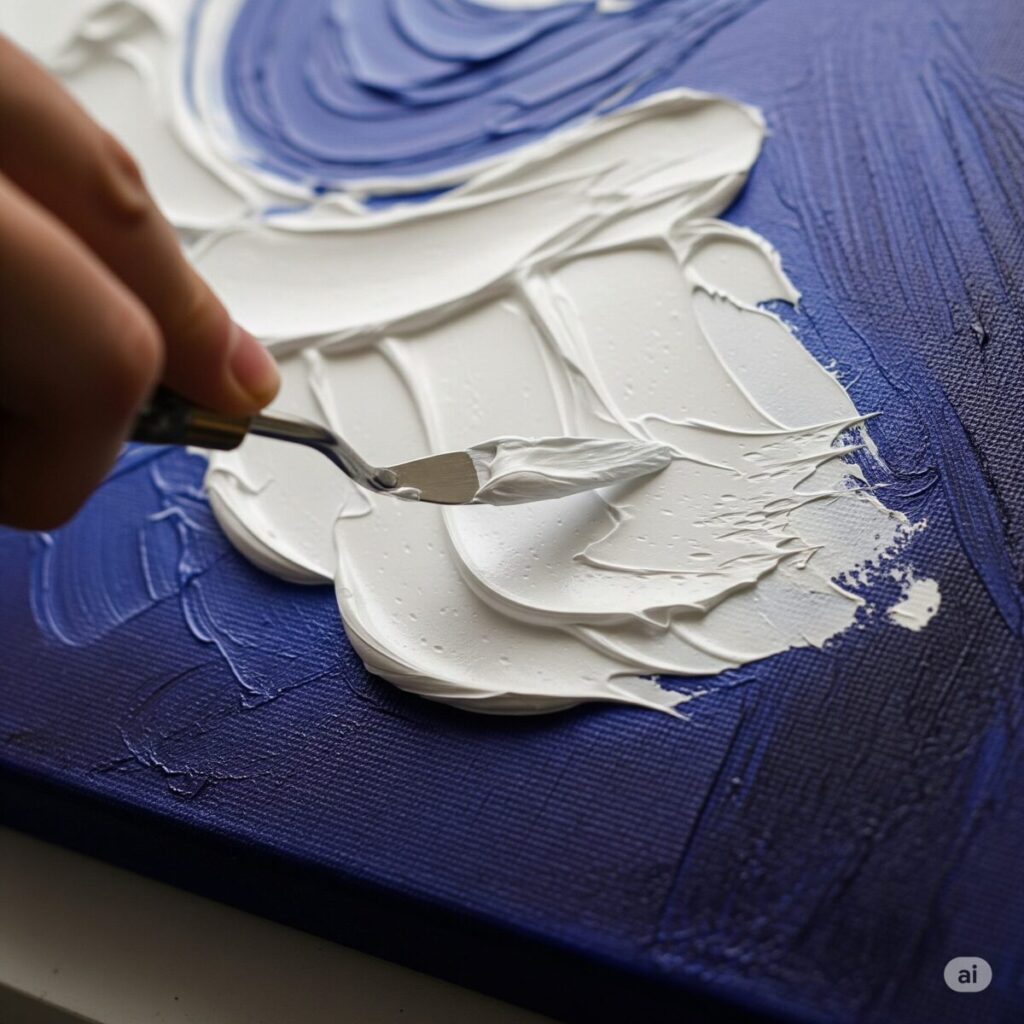
Experiment with impasto techniques by applying thick paint directly with the knife. This creates dimensional textures perfect for landscapes, still lifes, and abstract compositions.
Advanced Acrylic Painting Tools
As your skills develop, consider these additional tools:
Spray bottles maintain paint consistency and can create atmospheric effects Sponges offer unique textural possibilities for foliage, clouds, and abstract elements Painting mediums expand creative possibilities with effects like cracking, pouring, and extended working time
Workspace Setup and Organization
Organize your acrylic painting tools for maximum efficiency. Keep water containers accessible, arrange brushes by size, and maintain a clean palette area. Good lighting is crucial—natural north light is ideal, but full-spectrum LED lights work well for evening sessions.
Cleaning and Maintenance
Immediate cleaning prevents paint buildup that can ruin brushes. Use lukewarm water and gentle soap for daily cleaning. For stubborn paint, brush restorers like The Master’s Brush Cleaner effectively remove dried acrylic without damaging bristles.
Budget-Friendly Alternatives
Pizza box easels provide adequate support for small canvases Plastic palette knives offer 90% of the functionality at a fraction of the cost DIY stay-wet palettes work as well as commercial versions
Quick Start Techniques
Dry brush technique creates texture by using minimal paint on a nearly dry brush Palette knife application builds impasto effects and bold textures Dotting with erasers creates perfect circles for flowers and decorative elements
These techniques, along with many others covered in our acrylic painting techniques guide, become second nature with practice and the right tools.
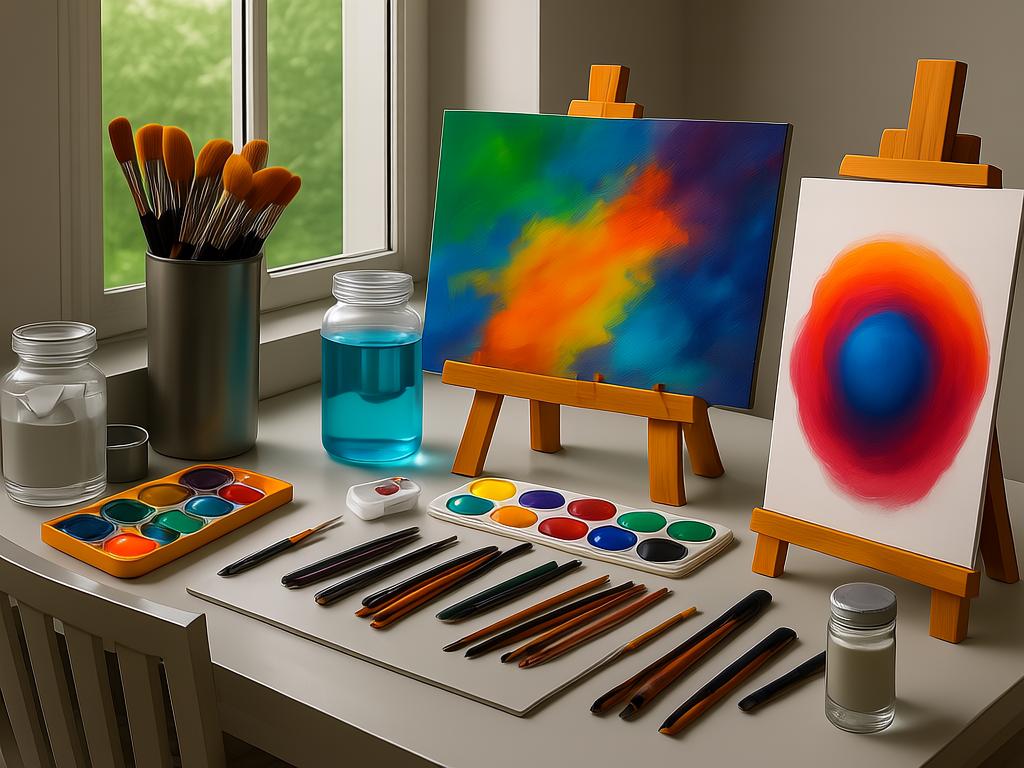
Frequently Asked Questions
Can I use watercolor brushes for acrylics? While possible, watercolor brushes won’t last as long with acrylics. Synthetic acrylic brushes are specifically designed for these paints.
How do I prevent acrylic paint from drying on my palette? Use a stay-wet palette, mist regularly with water, or work in smaller paint quantities.
What’s the most important tool for beginners? Quality synthetic brushes make the biggest difference in your painting experience and results.
How much should I spend on starting supplies? A complete basic kit costs $50-100, but you can start with essentials for under $50.
Conclusion
Success with acrylic painting depends more on understanding your tools than owning expensive equipment. Start with quality basics, learn proper care techniques, and gradually expand your collection as your skills develop. With the right acrylic painting tools and consistent practice, you’ll be creating impressive artwork sooner than you think.
Remember that every professional artist started with basic supplies. Focus on mastering fundamental techniques with simple tools before investing in advanced equipment. Your artistic journey begins with that first brushstroke—make sure you have the right tools to support your creative vision.
Additional Resources:

